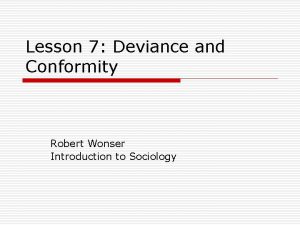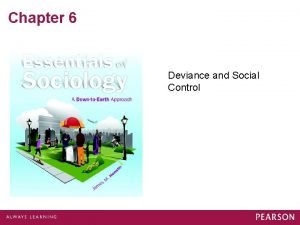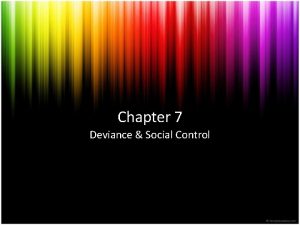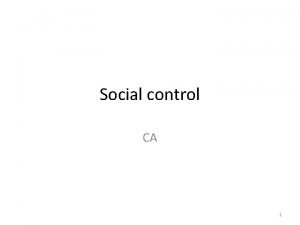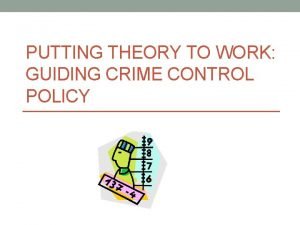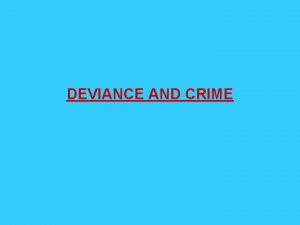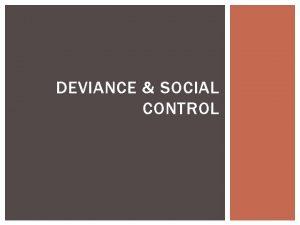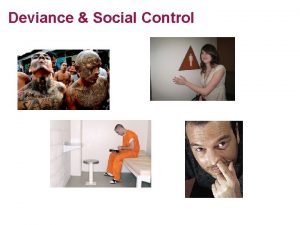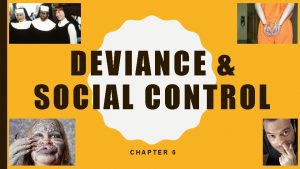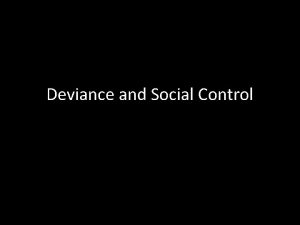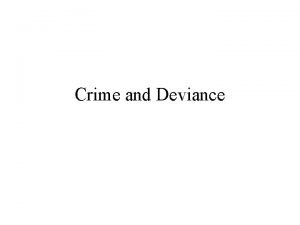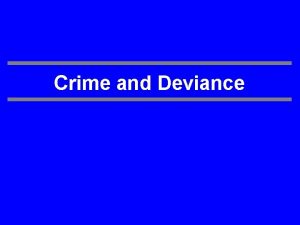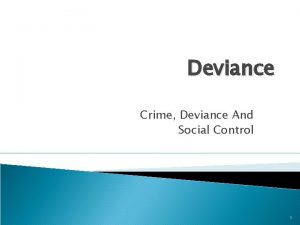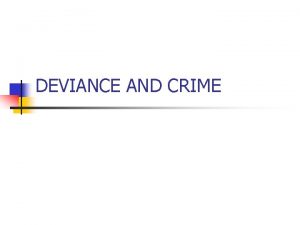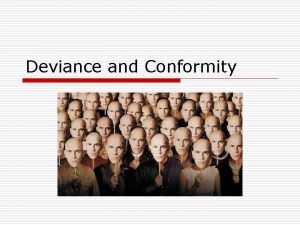6 Deviance Crime and Social Control Deviance is














- Slides: 14

6. Deviance, Crime, and Social Control

• Deviance is the violation of social norms, whereas crime is law breaking. • Deviance is relative. This means that there is no absolute way of defining a deviant act. Deviance can only be defined in relation to a particular standard, but no standards are fixed or absolute. As such deviance varies from time to time and place to place.

Types of crime • Crimes against People: - Murder or homicide. - Rape and personal assault. - Child abuse. - Sexual harassment. • Crimes against Property. • Computer crime. • Victimless crime. • Organized crime.

Organized crime refers to groups and organizations dedicated solely to criminal activity. Historically, leaders of organized crime, or “crime families, ” have come from different ethnic groups. Organized crime activities are of three basic types: 1. Legal activities and businesses, such as restaurants. 2. Illegal activities, such as importing and selling narcotics, gambling, and running prostitution rings. 3. Racketeering, or the systematic extortion of funds for purposes of “protection. ”

Social values and norms Social values are ideas and beliefs about what is write and what is wrong, and the important standards which are worth maintaining and achieving in any society. There are four aspects of the sociological concept of value. 1. Values exist at different levels of generality or abstraction; 2. Values tend to be hierarchically arranged; 3. Values are explicit and implicit in varying degrees; 4. Values often are in conflict with one another.

Social norms are rules developed by a group of people that specify how people must, should, may, should not, and must not behave in various situations. • “Must" is often labeled "more”. Example: wear clothing. • ‘Should' is a "folk-way “. Example: clothes should be clean. • "May" is a “choice”. Example: boys may select to wear jeans. • ‘Should-not' and the 'must-not‘. Examples: one should not dump garbage in the street. One must not kill another person.

1. Some norms apply in specific contexts, settings, or situation, i. e. laughing at a funeral. 2. Some norms apply to the behavior of members of certain groups or collectivities but not to others, i. e. consuming alcohol. 3. Some norms apply to everyone in a given society, i. e. killing a person. Norms indicate that violators will be punished or sanctioned. There is NOT and has NEVER been a society where "anything goes. " It would not last long. Thus, some minimal level of punishment of wrongdoing is necessary to ensure a minimal level of social order.

Social control “The way in which entire social order coheres and maintain itself-how it operates as a whole, as a changing equilibrium. “ To understand this concept, there are three important things to learn. 1. Social control is an influence, which may be applied through various means of control like public opinion, force, public appeal, and social and religious organizations. 2. This influence should be implemented by society-there are so many groups who practice this influence, like family, mosque , state, school , neighborhood, clubs. 3. The influence should be implemented for promoting the welfare and interest of the entire group.

Forms of social control 1. Internalization of norms and values in which we will talk about internal and external social control, and 2. The use of sanctions, which can be either positive (rewards) or negative (punishment) in which we will talk about formal and informal social control.

Need for Social Control 1. No two persons are alike in their nature, ideas, attitudes and interests. 2. Maintaining order in the society. 3. Social unity. 4. No two men are alike in their attitudes, ideas, interests and habits

Aims of social control The aims of social control are to bring about conformity, solidarity and continuity of particular group or society

Criminal justice is the system of practices and institutions of governments directed at maintaining social control and preventing crime, or sanctioning those who violate laws with criminal penalties and rehabilitation efforts. The criminal justice system consists of three main parts: (1) Legislative (create laws); (2) adjudication (courts); and (3) corrections (jails, prisons, probation and parole).

The poor are more likely than the wealthy to be arrested for any category of crime. Why? • Unlike the wealthy who can commit crimes in the seclusion of their offices or homes, the poor have little privacy. This means the poor are more visible to the police, as well as to other citizens who may complain to law officials. • Biases in police training and experience may cause police officers to blindly blame crimes on certain groups, such as people of color and lower-class juveniles. • Finally, the fear of political pressure may prompt law enforcement officers to avoid arresting more affluent and influential members of society.

The criminal justice system and prison system serve society in several potentially useful ways: By being placed in jail, convicted criminals receive “just rewards, ” or retribution, for their crimes. Prisons ideally should deter crimes. As theory goes, prisons are supposed to keep released criminals from offending again and potential criminals from committing crimes. . Prisons isolate criminals from the general public. • Prisons ideally serve to rehabilitate criminals into productive citizens who no longer commit crimes. • Today's prisons are overcrowded, and excessively bad conditions cause prisoners to experience a wide variety of health problems
 Chapter 7 deviance crime and social control
Chapter 7 deviance crime and social control Deviance avowal
Deviance avowal Deviants chapter 8
Deviants chapter 8 Guided reading activity deviance and social control
Guided reading activity deviance and social control Chapter 6 deviance and social control
Chapter 6 deviance and social control Logistic regression residual deviance
Logistic regression residual deviance Crime and deviance sociology revision
Crime and deviance sociology revision Difference between crime and deviance
Difference between crime and deviance Crime and deviance definition
Crime and deviance definition Marxism crime and deviance
Marxism crime and deviance Hirschi social bonds
Hirschi social bonds External social control
External social control Characteristics of social control
Characteristics of social control Crime control policies
Crime control policies Crime control policies
Crime control policies

